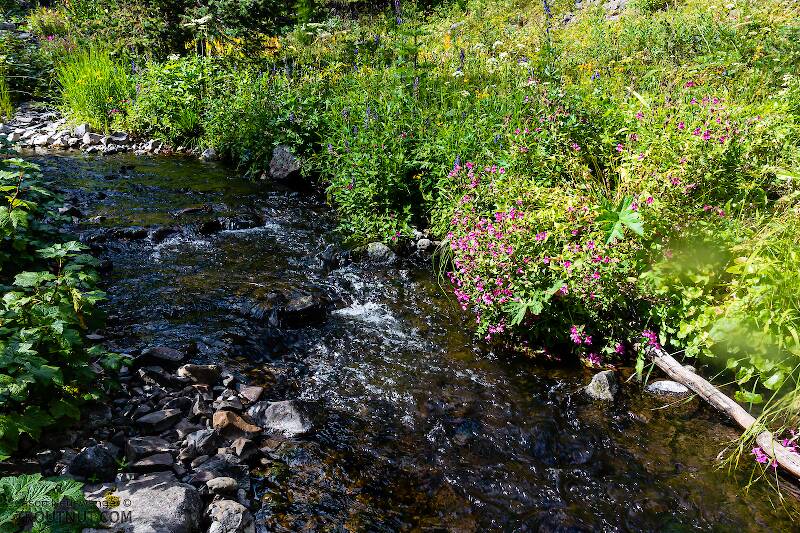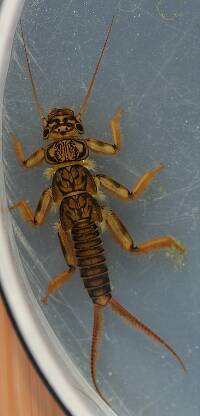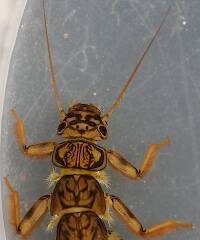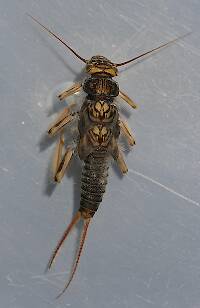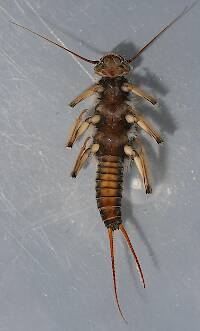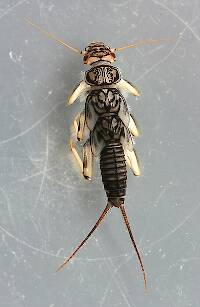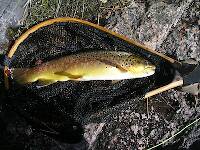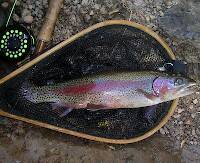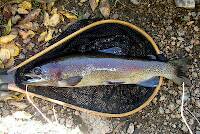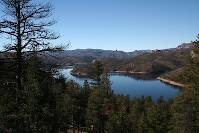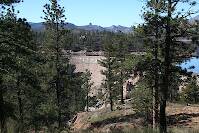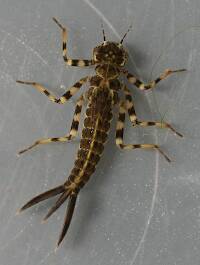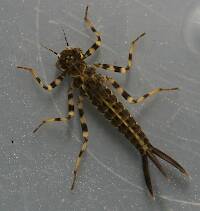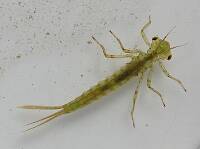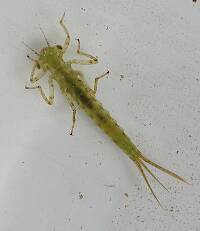
Blue-winged Olives
Baetis
Tiny Baetis mayflies are perhaps the most commonly encountered and imitated by anglers on all American trout streams due to their great abundance, widespread distribution, and trout-friendly emergence habits.
Featured on the forum

I caught this tiny larva without a case, but it seems to key pretty clearly to to Glossosomatidae. From there, the lack of sclerites on the mesonotum points to either Glossosoma or Anagapetus. Although it's difficult to see in a 2D image from the microscope, it's pretty clear in the live 3D view that the pronotum is only excised about 1/3 of its length to accommodate the forecoxa, not 2/3, which points to Glossosoma at Couplet 5 of the Key to Genera of Glossosomatidae Larvae.

Troutnut is a project started in 2003 by salmonid ecologist Jason "Troutnut" Neuswanger to help anglers and
fly tyers unabashedly embrace the entomological side of the sport. Learn more about Troutnut or
support the project for an enhanced experience here.
Martinlf on Nov 29, 2006November 29th, 2006, 12:02 pm EST
If new members have not yet checked out "Landscapes & Trout" take a look to see some of the most beautiful photos of streams you'll find anywhere. Jason's stomping ground is too far for a casual trip by me, but if it weren't I'd be walking the woods trying to find these brooks as much to see their unique geology firsthand as for the fish.
"He spread them a yard and a half. 'And every one that got away is this big.'"
--Fred Chappell
--Fred Chappell
Gripngrin on Nov 30, 2006November 30th, 2006, 4:11 pm EST
You are right-on Louis. Jason's landscape photography is awesome.
Frankly, I am a little jealous of the colors. So rich and vibrant. Beautiful contrasts.
Sitting on high on the Colorado plateau, our trout streams are mostly pine - some aspen, cottonwoods & willows. Lots & lots of green. Almost monochromatic. We do not have the rich oranges, golds and yellows, except in the fall for a few brief weeks.
Jason, which lens do you like to use? Filters?
Mike
Frankly, I am a little jealous of the colors. So rich and vibrant. Beautiful contrasts.
Sitting on high on the Colorado plateau, our trout streams are mostly pine - some aspen, cottonwoods & willows. Lots & lots of green. Almost monochromatic. We do not have the rich oranges, golds and yellows, except in the fall for a few brief weeks.
Jason, which lens do you like to use? Filters?
Mike
Grip'n Grin Mike
Troutnut on Nov 30, 2006November 30th, 2006, 5:15 pm EST
I'm really glad you guys enjoy the photos! That makes it easier to lug my tripod and digital SLR body/case/lenses around for miles when I find a pretty spot (although one day hiking 9 miles with that stuff this September just about did me in).
My main lens for landscape shots is Canon's EF-S 10-22mm lens. I sometimes use the 70-200mm f/4 L, which is pretty nice, although I often wish I had the f/2.8 version with image stabilization. If I ever stumble upon a money tree I'll be sure to fix that.
I use a polarizing filter for many of my shots, which helps with the colors. I also use a 6-stop ND filter to blur the water. I've had a few polite complaints about overuse of that effect. I don't quite agree, because I really like the large-scale structure and sense of motion it adds to most of the pictures, but next season I will try to balance it out by getting a little closer to the water and shooting stop-action exposures. I don't really like the texture of water "frozen" by a picture at normal landscape / stream portrait distances, but I think it will make for interesting pictures if I get in close enough to the turbulence to see interesting lines and forms rather than just a rough texture. Maybe the pictures will be crap, too. I'll just have to try it and see.
The colors and contrast are all in the post-processing, for which I use RawShooter Pro (which has unfortunately been discontinued as the developers all jumped over to Adobe Lightroom) and Photoshop. RawShooter has a "vibrance" tweak which is much nicer than playing with saturation, and in Photoshop my favorite trick is local contrast enhancement. I'm sure you know this as a photographer Mike, but I always feel obligated to point out for the general audience that computer enhancement isn't "cheating" in any way because all digital photos are computer enhanced; I just do it manually rather than letting the camera's software do it automatically.
I'm quite jealous of your position in the Colorado Front Range, Mike! I visited there once when I was about 12. My first memory of actual live trout (I grew up in troutless northern Missouri) is from that trip, and I vividly remember seeing one around 12" spook and dart upstream in the clear water of the Colorado River in Rocky Mountain National Park. I didn't get to fish because we were on a sightseeing trip -- that drove me crazy! It's been a downward spiral into troutnuttery ever since...
My main lens for landscape shots is Canon's EF-S 10-22mm lens. I sometimes use the 70-200mm f/4 L, which is pretty nice, although I often wish I had the f/2.8 version with image stabilization. If I ever stumble upon a money tree I'll be sure to fix that.
I use a polarizing filter for many of my shots, which helps with the colors. I also use a 6-stop ND filter to blur the water. I've had a few polite complaints about overuse of that effect. I don't quite agree, because I really like the large-scale structure and sense of motion it adds to most of the pictures, but next season I will try to balance it out by getting a little closer to the water and shooting stop-action exposures. I don't really like the texture of water "frozen" by a picture at normal landscape / stream portrait distances, but I think it will make for interesting pictures if I get in close enough to the turbulence to see interesting lines and forms rather than just a rough texture. Maybe the pictures will be crap, too. I'll just have to try it and see.
The colors and contrast are all in the post-processing, for which I use RawShooter Pro (which has unfortunately been discontinued as the developers all jumped over to Adobe Lightroom) and Photoshop. RawShooter has a "vibrance" tweak which is much nicer than playing with saturation, and in Photoshop my favorite trick is local contrast enhancement. I'm sure you know this as a photographer Mike, but I always feel obligated to point out for the general audience that computer enhancement isn't "cheating" in any way because all digital photos are computer enhanced; I just do it manually rather than letting the camera's software do it automatically.
I'm quite jealous of your position in the Colorado Front Range, Mike! I visited there once when I was about 12. My first memory of actual live trout (I grew up in troutless northern Missouri) is from that trip, and I vividly remember seeing one around 12" spook and dart upstream in the clear water of the Colorado River in Rocky Mountain National Park. I didn't get to fish because we were on a sightseeing trip -- that drove me crazy! It's been a downward spiral into troutnuttery ever since...
Jason Neuswanger, Ph.D.
Troutnut and salmonid ecologist
Troutnut and salmonid ecologist
Quick Reply
Related Discussions
Topic
Replies
Last Reply
1
Aug 5, 2019
by Martinlf
by Martinlf
1
Jan 29, 2016
by Martinlf
by Martinlf
Re: DIY Photo-Microscope with a smart cell phone, iPod Touch, iPad (aka Smart-D-Scope)
In the Photography Board by LowBudget
In the Photography Board by LowBudget
1
Apr 1, 2014
by Entoman
by Entoman

